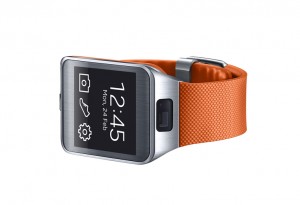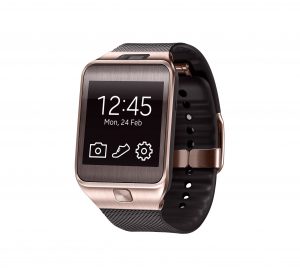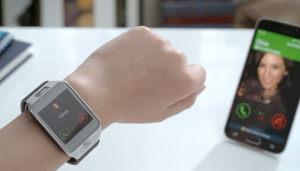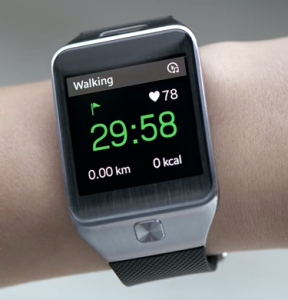I have to admit, I snickered a bit when Samsung announced they weren’t going to use the new Android Wear OS for their latest Gear models. The original Galaxy Gear was a decent device sure, but it had its shortcomings: mediocre battery life, an uninspired design, and a very limited supply of apps. That being said it was Samsung’s first attempt at a smartwatch, which means one should expect a hindrance or two.
With the new Gear models, instead of using the Android OS designed specifically for wearable devices Samsung opted for Tizen – their own proprietary platform. That means the Gear 2, Gear 2 Neo and Gear Fit are all running on the same Tizen based OS. If you didn’t already know, the original Galaxy Gear was running Android under the hood. How did the big swap turn out? Well let’s find out in our Samsung Galaxy Gear 2 Review.
Overview
| Samsung Galaxy Gear 2 Review | |
| Overall: (4/5) | |
| Build: (5/5) | |
| Design: (4/5) | |
| Customization: (4/5) | |
| Functionality: (4.5/5) | |
| Compatibility: (3/5) | |
The Gear 2 has been improved quite a bit in terms of design. When it comes to the UI, not much has changed even though Samsung swapped the OS. In fact, if you sit the original Galaxy Gear right next to the Gear 2 the onscreen UI looks identical. The battery life has improved, but it’s still not at a point where it needs to be. The camera is about the same, but they removed it from the strap and attached it to the main body of the device – where it should have been all along. Despite the improvements I can’t help but feel that Samsung is out of touch with consumers, however.
The app selection has not improved at all for the latest iteration – the swap to Tizen is mostly to blame for this. The price is still a bit high for something of a companion device. Lastly, the compatibility has improved a bit yet Samsung still made the Gear 2 exclusive to Sammy brand handsets.
Is it worth the cost? If you can get a great deal or you’re buying the Gear 2 with a compatible Samsung handset then go for it. It’s definitely a step-up from the original Galaxy Gear. That being said, Samsung still has a long way to go before they revolutionize the market – with any of their smartwatch models.
- Overall: 4/5 – Samsung’s Gear 2 is a much better smartwatch than its predecessor, but there are still a few things holding it back from dominating the market.
Build
 There’s not much to talk about here, at least when comparing the Gear 2 to its predecessor. The same polished metal chassis, and 1.63” screen remains at the forefront. A physical button has been added and it feels sturdy, which to me is important. I’ve owned so many devices that had a shoddy button setup, like a power or wake button that wore down and barely worked after a month of normal use.
There’s not much to talk about here, at least when comparing the Gear 2 to its predecessor. The same polished metal chassis, and 1.63” screen remains at the forefront. A physical button has been added and it feels sturdy, which to me is important. I’ve owned so many devices that had a shoddy button setup, like a power or wake button that wore down and barely worked after a month of normal use.
Overall the Gear 2 has a fantastic build, and the fact that it’s now IP67 dust-resistant and waterproof (up to one meter for 30 minutes) means that you’ll have a hard time breaking this baby. Of course – and I hate to keep bringing this up – the fact that the wrist band is now replaceable makes the Gear 2 even more substantial. If something goes awry with the stock band or even one that you installed yourself you can simply remove it and attach yet another one.
- Build: 5/5 – The overall build quality is fantastic, and thanks to the replaceable band support and IP67 dust and water resistance your Gear 2 won’t be breaking any time soon.
Design
 When it comes to design Samsung clearly listened to consumers and critics. The tacky screws that plagued the original are gone from the front face of the watch. The camera – which is somewhat unsightly on the original model – has been moved to the device chassis instead of the wristband. Samsung stuck with the same polished metal body, and the screen size is the same. One of the biggest differences is that users can now swap out the wristband with a custom one – and pretty easily I might add. The Gear 2 uses a standard 22mm wristband and there’s even a latch on the device that easily ejects the installed one. What does this mean for Gear 2 owners? It means if you want a leather band, or even a neon glow-in-the-dark one you can certainly do that. Yay.
When it comes to design Samsung clearly listened to consumers and critics. The tacky screws that plagued the original are gone from the front face of the watch. The camera – which is somewhat unsightly on the original model – has been moved to the device chassis instead of the wristband. Samsung stuck with the same polished metal body, and the screen size is the same. One of the biggest differences is that users can now swap out the wristband with a custom one – and pretty easily I might add. The Gear 2 uses a standard 22mm wristband and there’s even a latch on the device that easily ejects the installed one. What does this mean for Gear 2 owners? It means if you want a leather band, or even a neon glow-in-the-dark one you can certainly do that. Yay.
The original Gear also had a speaker embedded in the wristband clasp. Naturally, since the wristband is now removable that is no longer where it resides. Sammy also added a single button just below the screen reminiscent to the one on their Galaxy handsets.
A charging cradle is no longer necessary, but the Gear 2 still uses a proprietary charger which means if you lose it or muck it up somehow, you’re going to be doling out a nice chunk of change for another one before you can use the device regularly again.
As you can see there are still some setbacks, but the Gear 2 has improved remarkably from the original model.
- Design: 4/5 – minor nuances aside the Gear 2 is much better than the original model, and the replaceable band support was definitely necessary.
Customization
This time around you can customize the watchband by swapping the stock one with one of your own choosing. Any standard 22mm band will work just fine, and it doesn’t matter whether you choose leather, plastic, rubber or something else. That option alone makes the Gear 2 worlds better than the original model.
When it comes to personalizing the software, UI and watchfaces you’ll be using Gear Manager – Samsung’s mobile app designed to control the smartwatch. You can change most of the settings on the Gear directly, but you’ll probably never use the watch to do your bidding – it’s too clunky and takes forever. It’s much easier to pull out your smartphone and change the settings through Gear Manager before synching everything up.
Right now there aren’t very many apps to install on the Gear 2, and it’s probably going to stay that way for a while. Unfortunately, by making the move to Tizen Sammy rendered all apps developed for the previous model useless. You’ll have to look for separate content for the Gear 2, and Gear 2 Neo. A bevy of new stock apps are available such as a stopwatch, phone dialer, media controller, contacts list and call logs. There’s also a health app similar to S Health (on the Galaxy handsets) that allows you to track fitness stats.
For the rest of the device what you see is what you get. While the personalization options are still limited, you have a lot more freedom with the Gear 2 than its predecessor. That’s always a plus, but there is definitely room for improvement (listen up Sammy).
- Customization: 4/5 – most of the changes are software based, and the improved Gear Manager offers more customization on that front – plus you can swap out the wrist band now for any 22mm sized band.
Functionality
 I’m not going to bother talking about the standard smartwatch features. Everything the original Gear could do, the Gear 2 can also do. The notifications are much improved and seem more fluid. You can make calls from the phone – with a connected device of course – and draw up text messages through S Voice. The S Voice dictation functionality can be a bit shoddy at times, but I don’t know a similar voice platform that doesn’t have the same issues – Google Now and Siri both suffer from it, as I’m sure Microsoft’s Cortana will too.
I’m not going to bother talking about the standard smartwatch features. Everything the original Gear could do, the Gear 2 can also do. The notifications are much improved and seem more fluid. You can make calls from the phone – with a connected device of course – and draw up text messages through S Voice. The S Voice dictation functionality can be a bit shoddy at times, but I don’t know a similar voice platform that doesn’t have the same issues – Google Now and Siri both suffer from it, as I’m sure Microsoft’s Cortana will too.
You can do other things like read incoming Gmail content, but you can’t reply without first taking out your connected phone. In fact, a lot of the tasks require you to have your phone nearby so keep that in mind when you go to pick one of these up.
The biggest change in the Gear 2 is the implementation of an optical heart rate monitor. If you’ve seen how the heart rate monitor on the Galaxy S5 works then you should be familiar with the Gear 2 support. It works with the native fitness apps on the device to help you calculate basic health information. Not everyone will take advantage of something like this but it’s great if you don’t want to wear a Fitbit and the Gear 2 at the same time.
The same hardware is available in the Gear 2, such as Bluetooth 4.0, 4GB of internal storage, a mic, an accelerometer, and an IR blaster. If you really want to know what the Gear 2 is working with for silicon, it has a 1GHz dual-core chip. The battery is much larger this time around weighing in at 300mAh.
- Functionality: 4.5/5 – it does exactly what you’d expect a smartwatch to do, and the new optical heart rate monitor works great with the native health tracking apps
Compatibility
This is where the Gear series gets docked a bunch in terms of score. The Gear 2 – like the original – is not compatible with a wide variety of devices, only Samsung branded handsets to be precise. This time around Sammy chose to work with more of their own handsets, which is great. You can see the full list of compatible devices below this review. All of that aside, Samsung still holds the most market share when it comes to mobile owners so it might not be a bad thing that the Gear 2 is only compatible with their own brand. If you already own a compatible Samsung handset then the Gear 2 will be a great fit, otherwise you’re out of luck.
- Compatibility: 3/5 – the Gear 2 is only compatible with a select few Samsung branded handsets, but there are a few more compatible devices this time around than the original
Conclusion
 The Gear 2 is a vast improvement over the original model especially when it comes to design. The design is even more appealing – the screws and hideous wart of a camera are gone – the build quality is great and the necessary functionality is all there. Sammy even decided to be generous this time around and allow users the option to swap out the stock wristband for any standard 22mm one of their choosing. Users will even have access to some pretty standard personalization options through the Gear Manager app.
The Gear 2 is a vast improvement over the original model especially when it comes to design. The design is even more appealing – the screws and hideous wart of a camera are gone – the build quality is great and the necessary functionality is all there. Sammy even decided to be generous this time around and allow users the option to swap out the stock wristband for any standard 22mm one of their choosing. Users will even have access to some pretty standard personalization options through the Gear Manager app.
The third party app selection is pretty much nonexistent. If you owned the Gear, then you’ll have to look for brand new apps for the Gear 2 – thanks to Sammy’s decision to swap from Android to Tizen. It also means that developers will need to create entirely new apps for the Gear 2, and Gear 2 Neo devices. Seeing as it took a while for the original Gear’s app market to grow, the same can probably be said of the new lineup. The stock apps should work great in the meantime. As of the time of this writing there were no Facebook or Twitter apps available which should eventually change. Just don’t pick one of these up within the next few months and expect to jump on all your social media accounts – unless you’re using the device browser, which is… well, let’s just say it’s not recommended.
There is one glaring issue to note – the Gear 2 is only compatible with a handful of Samsung handsets. That means unless you’re packing one of Samsung’s latest and greatest, you should be looking elsewhere. You will need a paired smartphone to take full advantage of the Gear 2, so don’t pick one up thinking you can use it without one. For $300, it’s not a bad device but if you don’t’ own a Samsung handset you might be better off waiting for Android Wear to launch later this summer.
We hope you enjoyed our Samsung Gear 2 review and it proved useful in your search for the perfect smartwatch. Stay tuned for our coverage of the Samsung Gear lineup!
Compatible Galaxy Devices
Samsung claims that the compatibility list will eventually expand.
- Samsung Galaxy S5
- Galaxy Grand 2
- Galaxy Note 3
- Galaxy Note 3 Neo
- Galaxy Note 2
- Galaxy S4
- Galaxy S3
- Galaxy S4 Zoom
- Galaxy S4 Active
- Galaxy S4 mini
- Galaxy Mega 6.3
- Galaxy Mega 5.8
- Galaxy Note 10.1 (2014 Edition)
- Galaxy NotePRO (12.2)
- Galaxy TabPRO (12.2/10.1/8.4)
